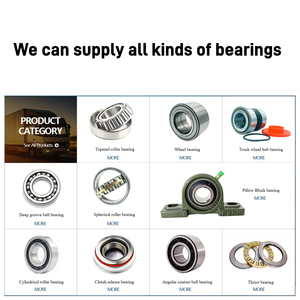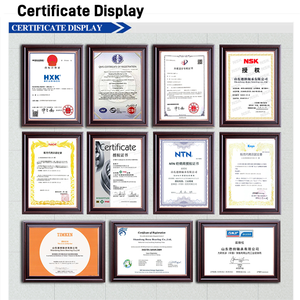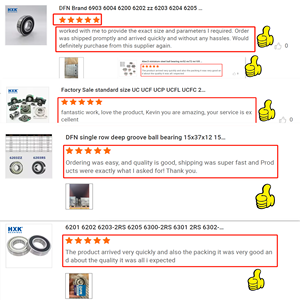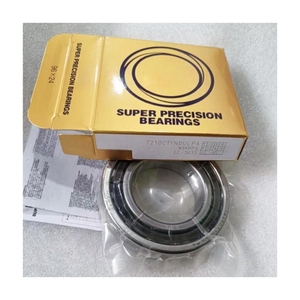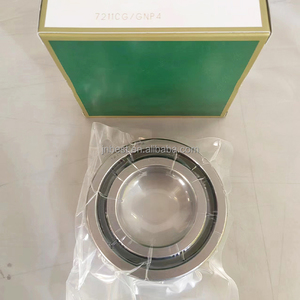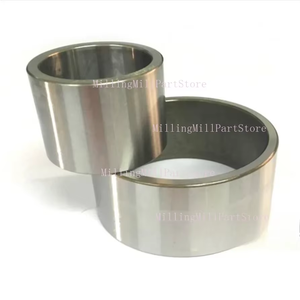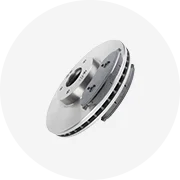Types of Spindle Bearing Assembly
A spindle bearing assembly is a critical component that supports rotating spindles while minimizing friction. In lathe machines, the spindle rotates the workpiece, making this assembly the heart of the entire operation. Without a properly functioning spindle bearing assembly, the lathe cannot perform accurately, affecting machining quality and precision.
Important: The right spindle bearing assembly ensures smooth, even rotation of the workpiece during machining operations, directly impacting the quality of the finished product.
Ball Bearings
The most common bearing type, featuring inner and outer races with steel balls between them. These bearings offer:
- High-speed capabilities
- Smooth operation
- Moderate load capacity
Best for: High-speed applications with light to moderate loads
Cylindrical Roller Bearings
Similar to ball bearings but with rollers instead of balls in a parallel arrangement, providing:
- Increased contact area
- Superior load capacity
- Excellent radial load support
Best for: Heavy industrial applications requiring high load capacity
Angular Contact Bearings
Designed with a contact angle between balls and races that allows:
- Combined axial and radial load support
- High precision operation
- Excellent performance at high speeds
Best for: Precision applications requiring both axial and radial support
Tapered Roller Bearings
Consisting of a cone, cups, and rollers that move in a tapered motion:
- Exceptional axial and radial load handling
- High stiffness characteristics
- Ideal for heavy-duty applications
Best for: Large machinery and applications with combined heavy loads
| Bearing Type | Speed Rating | Load Capacity | Precision Level | Common Applications |
|---|---|---|---|---|
| Ball Bearings | Very High | Moderate | Medium to High | CNC machine tools, small lathes |
| Cylindrical Roller | High | High | Medium | Industrial machinery, heavy-duty lathes |
| Angular Contact | Very High | Medium to High | Very High | Precision grinding machines, high-speed spindles |
| Tapered Roller | Medium | Very High | Medium | Truck wheels, large machinery, wheel hubs |
Specifications and Maintenance of Spindle Bearing Assemblies
Selecting the appropriate spindle bearing assembly requires careful consideration of several critical specifications that will impact performance, longevity, and overall machine operation.
| Specification | Description | Importance |
|---|---|---|
| Size and Mounting | Must be compatible with spindle dimensions and machine body | Critical - ensures proper fit and alignment |
| Load Capacity | Should exceed maximum operational loads by 20-30% | High - prevents premature failure |
| Speed Rating | Must accommodate both continuous and peak operational speeds | Critical - directly impacts performance and safety |
| Precision and Tolerance | Determines rotational accuracy and dimensional precision | High - affects machining quality |
| Cooling and Lubrication | System for continuous lubricant distribution to all bearings | Critical - extends lifespan and maintains performance |
| Material and Coating | Steel or ceramic with specialized coatings for environment | Medium - affects durability and corrosion resistance |
| Vibration and Noise | Must operate within acceptable vibration and noise limits | Medium - indicates bearing health and affects precision |
| Maintenance Accessibility | Design allows for inspection, lubrication, and replacement | Medium - reduces downtime during maintenance |
Maintenance Tip: Establish a regular maintenance schedule that includes bearing inspection, lubrication monitoring, and vibration analysis to extend spindle bearing assembly life and prevent catastrophic failures.
Choosing Spindle Bearing Assemblies
Selecting the optimal spindle bearing assembly is crucial for ensuring machine performance, precision, and longevity. Consider these key factors during your selection process:
Load Capacity
The ability of a bearing to support both radial and axial forces without premature failure or deformation.
- Undersized bearings lead to premature wear and failure
- Oversized bearings cause increased friction and energy consumption
- Ideal selection: 20-30% above maximum anticipated loads
Speed Rating
The maximum rotational velocity at which a bearing can operate safely and efficiently.
- Higher speeds generate more heat and require better lubrication
- Exceeding ratings leads to reduced lifespan and precision
- Consider both continuous and peak operation speeds
Precision Class
The manufacturing accuracy that determines rotational precision and runout tolerances.
- Higher precision classes offer better rotational accuracy
- Critical for applications requiring tight dimensional control
- Balance precision needs with cost considerations
Material and Coatings
Construction materials and surface treatments that enhance performance and durability.
- Standard: High-quality bearing steels (AISI 52100, 440C)
- Advanced: Ceramic materials for high-performance applications
- Coatings: Chromium plating, nitride treatments for wear resistance
Warning: Never select a spindle bearing assembly based solely on price. The cost of bearing failure—including downtime, replacement parts, and potential damage to other components—far exceeds the initial savings from choosing lower-quality bearings.
How to DIY and Replace Spindle Bearing Assembly
Replacing a spindle bearing assembly requires precision, patience, and the right tools. Follow this comprehensive guide to safely complete this maintenance task.
Required Tools and Materials
| Item | Purpose | Alternatives |
|---|---|---|
| New spindle bearing assembly | Replacement component | Must match original specifications |
| Socket wrench set | Removing fasteners | Combination wrenches |
| Torque wrench | Proper bolt tightening | Not recommended to substitute |
| Hammer | Light tapping for removal | Rubber mallet |
| Bearing puller | Removing old bearings | Slide hammer (for some applications) |
| Press tool | Installing new bearings | Bearing driver set |
| Grease | Lubrication | Manufacturer-recommended lubricant |
Step-by-Step Replacement Procedure
- Prepare the work area - Ensure you have a clean, well-lit workspace with enough room to safely work on the vehicle or equipment.
- Gather tools and parts - Collect all necessary tools and ensure the new spindle bearing assembly is compatible with your specific application.
- Secure the equipment - Use a jack to lift the vehicle or equipment and secure it with jack stands for safety.
- Remove the wheel - Take out the wheel bolts and remove the wheel to access the spindle assembly.
- Disconnect brake components - Carefully remove the brake caliper and rotor, ensuring proper support of components and handling of brake fluid lines.
- Remove the axle nut - Use the socket wrench to loosen and remove the axle nut securing the axle to the spindle.
- Disconnect suspension components - Remove the control arm and tie rod end connections from the spindle assembly.
- Extract the spindle - Carefully remove the spindle from the steering knuckle or suspension housing, noting orientation and assembly details.
- Remove old bearings - Use the bearing puller to extract the old bearings without damaging the spindle shaft.
- Clean the spindle - Thoroughly clean the spindle to remove dirt, grease, and old bearing residue before installation.
- Install new bearings - Use the press tool to carefully seat the new bearings onto the spindle, ensuring proper alignment.
- Reinstall the spindle - Return the spindle to its position in the steering knuckle or suspension housing.
- Reconnect suspension components - Attach the control arm and tie rod end, torquing all bolts to manufacturer specifications.
- Reinstall brake components - Reattach the brake rotor and caliper, ensuring all parts are clean and properly lubricated.
- Remount the wheel - Place the wheel back onto the spindle and tighten the wheel bolts in a crisscross pattern for even pressure.
- Test the assembly - Before full operation, test the wheel movement to ensure smooth rotation without binding or unusual noises.
Pro Tip: When installing new bearings, never apply force to the outer race when pressing onto the inner race, or vice versa. Always press on the race that is being fit. Using improper installation techniques is a common cause of premature bearing failure.
Frequently Asked Questions
A spindle bearing assembly is a critical component that maintains the proper position of wheels or rotating shafts in machinery. In vehicles, it supports the weight of the vehicle while allowing wheels to rotate smoothly with minimal friction. In machine tools like lathes, it provides the precision rotation necessary for accurate machining operations. The bearing assembly reduces friction between moving parts, enables smooth operation, and helps distribute loads evenly across the mechanism.
A spindle is a rod or shaft that serves as a rotating axis for another component. In vehicles, the spindle is attached to the suspension and provides the axis around which the wheel rotates. A hub, on the other hand, is the central part of a wheel that connects to the vehicle's axle. The hub contains the bearings that allow for rotation and serves as the mounting point for the wheel itself. In essence, the spindle provides the fixed axis, while the hub is the rotating component that attaches to the wheel.
Driving with a damaged spindle bearing is strongly discouraged for several important safety reasons:
- Unpredictable handling - Damaged bearings can cause steering problems and unpredictable vehicle behavior
- Excessive tire wear - Improper wheel alignment from bearing damage leads to premature and uneven tire wear
- Risk of catastrophic failure - Complete bearing failure can cause a wheel to seize or detach while driving
- Increased repair costs - Continuing to drive with damaged bearings can cause damage to related components
If you notice symptoms such as grinding noises, steering wheel vibration, or uneven tire wear, have your vehicle inspected immediately by a qualified mechanic.
Spindle bearing lifespan varies considerably depending on several factors including quality, application, maintenance, and operating conditions. In automotive applications, quality wheel bearings typically last between 85,000 to 100,000 miles under normal conditions. In industrial machinery, spindle bearings may last 3-5 years with proper maintenance. Factors that can significantly reduce bearing life include:
- Improper lubrication (either too little or too much)
- Contamination from dirt or water
- Excessive loads beyond rated capacity
- Misalignment during installation
- Extreme operating temperatures
Regular inspection and maintenance can significantly extend bearing life by identifying issues before they cause permanent damage.























